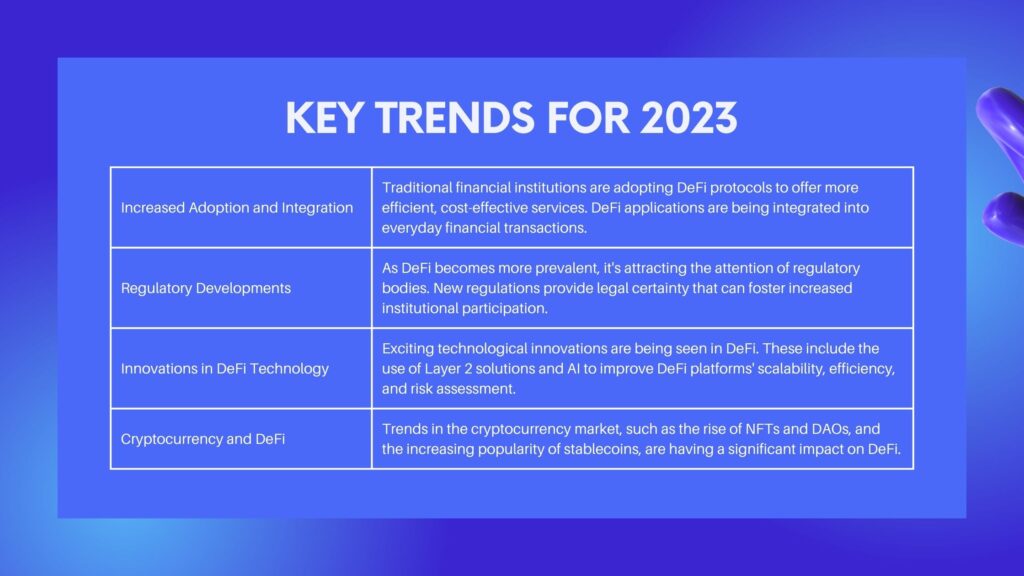Decentralized Finance, commonly known as DeFi, is transforming the financial landscape in unprecedented ways. By eliminating intermediaries and harnessing the power of blockchain technology, DeFi offers a revolutionary approach to conducting financial transactions. From lending and borrowing to insurance and asset management, DeFi platforms are democratizing access to financial services and fostering a new era of financial inclusion. As we venture further into 2023, it becomes increasingly clear that DeFi is not merely a transient trend, but a critical component of the future of finance.
The Evolution of DeFi
The inception of DeFi can be traced back to the advent of Bitcoin, the world's first decentralized cryptocurrency. Bitcoin demonstrated the potential of a decentralized financial system, laying the groundwork for the DeFi movement. Since then, DeFi has evolved tremendously, fueled by the advent of Ethereum and its smart contract capabilities, which opened up a multitude of possibilities for decentralized applications (dApps). Over the years, numerous DeFi platforms have emerged, each offering unique solutions to traditional financial challenges. As of 2023, DeFi has reached unprecedented levels of growth and adoption, establishing its place at the forefront of financial innovation.
Key Trends in DeFi for 2023
As we navigate through 2023, DeFi continues to make waves in the financial ecosystem. Several key trends have emerged that signal the trajectory of this disruptive technology. These trends range from increased adoption and integration, regulatory developments, innovative technology breakthroughs, to influences from the cryptocurrency market.

A. Increased Adoption and Integration
One of the most significant trends in 2023 is the increased adoption of DeFi by traditional financial institutions. Banks, insurance companies, and other financial service providers are increasingly recognizing the value of DeFi. By leveraging DeFi protocols, these institutions can offer their customers more efficient, cost-effective services. We're also witnessing the integration of DeFi applications into everyday financial transactions. For instance, decentralized exchanges (DEXs) are becoming popular platforms for trading digital assets, while lending and borrowing platforms are providing viable alternatives to traditional loans.
B. Regulatory Developments
As DeFi becomes more prevalent, it's inevitably attracting the attention of regulatory bodies. In 2023, we're seeing a surge in regulatory developments aimed at DeFi. While these regulations pose new challenges, they also provide a degree of legal certainty that can potentially foster increased institutional participation. Some jurisdictions have introduced licensing requirements for DeFi platforms, while others are developing frameworks for the taxation of DeFi transactions. As this regulatory landscape continues to evolve, it will undoubtedly shape the future trajectory of DeFi.
Are you interested in the legal aspects in blockchain? Check out our article on dao legal structures.
C. Innovations in DeFi Technology
This year, we're also seeing exciting innovations in DeFi technology. Blockchain and AI technologies are at the forefront of these innovations. For instance, Layer 2 solutions are being increasingly used to enhance the scalability and efficiency of DeFi platforms. AI, on the other hand, is being utilized to improve risk assessment models and automate decision-making processes in DeFi platforms.
D. Cryptocurrency and DeFi
The world of cryptocurrencies and DeFi are intrinsically linked. In 2023, the trends in the cryptocurrency market are having a significant impact on DeFi. The rise of non-fungible tokens (NFTs) and the growing interest in decentralized autonomous organizations (DAOs) are influencing the types of services offered by DeFi platforms. Moreover, the increasing popularity of stablecoins is bolstering the use of DeFi, providing a less volatile option for transactions.
In summary, DeFi is experiencing a dynamic evolution in 2023, shaped by a multitude of factors ranging from adoption and regulatory changes to technological innovations and cryptocurrency trends.
Predictions for DeFi and the Future of Finance
As we look towards DeFi and the future of finance beyond 2023, several key predictions can be made based on current trends and developments:
- Market Growth: The DeFi market is expected to experience substantial growth. As more institutions adopt DeFi protocols and technologies, and as regulatory frameworks become more defined, we can anticipate an increase in the overall market capitalization of DeFi.
- Technological Advancements: We expect to see continual technological advancements in the DeFi sector. Innovations will likely focus on improving scalability, efficiency, and security of DeFi platforms. The use of AI in DeFi could also become more prevalent, enhancing functionalities such as automated trading and risk assessment.
- Greater Integration with Traditional Finance: DeFi is predicted to become more deeply integrated into the traditional financial system. This could mean more partnerships between traditional banks and DeFi platforms, and an increase in DeFi services offered by mainstream financial institutions.
- Broader Adoption of DeFi Services: With increasing awareness and understanding of DeFi, more individuals and businesses are expected to use DeFi services for lending, borrowing, insurance, asset management, and more.
- Emergence of New DeFi Platforms and Services: As the DeFi space matures, we predict the emergence of new platforms and services. This could include new types of decentralized exchanges, lending platforms, and innovative DeFi applications we have yet to envision.
- Regulatory Evolution: As DeFi grows, so will the attention it receives from regulatory bodies. It's likely we'll see further evolution in DeFi-related regulations, which will shape the development and operation of DeFi platforms.
Conclusion
As we navigate through 2023, DeFi continues to shape the future of finance in profound ways. Its transformative influence extends from traditional financial institutions to everyday financial transactions, driven by innovative technologies and the dynamic cryptocurrency market. While there are challenges to overcome, including regulatory developments and technical hurdles, the potential for a more accessible and efficient financial system is undeniable.
The future is promising as we anticipate further growth, technological advancements, and broader adoption of DeFi services. As we continue exploring this exciting frontier, stay tuned for more insights and updates on the ever-evolving world of DeFi.
 en
en  pl
pl 












